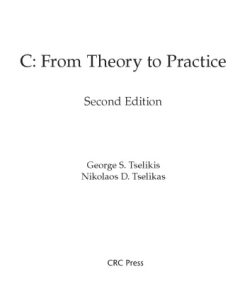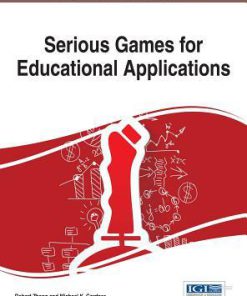Serious Games in Physical Rehabilitation From Theory to Practice 1st Edition by Bruno Bonnechere ISBN 3319661221 9783319661223
$50.00 Original price was: $50.00.$25.00Current price is: $25.00.
Serious Games in Physical Rehabilitation From Theory to Practice 1st Edition by Bruno Bonnechère – Ebook PDF Instant Download/Delivery: 3319661221, 9783319661223
Full download Serious Games in Physical Rehabilitation From Theory to Practice 1st Edition after payment

Product details:
ISBN 10: 3319661221
ISBN 13: 9783319661223
Author: Bruno Bonnechère
Marketing text: This innovative book explores how games can be serious, even though most people generally associate them with entertainment and fun. It demonstrates how videogames can be a valuable tool in clinics and demonstrates how clinicians can use them in physical rehabilitation for various pathologies. It also describes step by step their integration in rehabilitation, from the (gaming) technology used to its application in clinics. Further, drawing on an extensive literature review, it discusses the pros and cons of videogames and how they can help overcome certain obstacles to rehabilitation. The last part of the book examines the main challenges and barriers that still need to be addressed to increase and improve the use and efficacy of this new technology for patients. The book is intended for physiotherapists and clinicians alike, providing a useful tool for all those seeking a comprehensive overview of the field of serious games and considering adding it to conventional rehabilitation treatment.
Serious Games in Physical Rehabilitation From Theory to Practice 1st Table of contents:
1: The Technology
1.1 The Computers
1.2 The Graphical (R)evolution
1.3 The Three-Dimensional Environment
1.4 The Internet
1.5 The Commercial Video Games
1.5.1 From Games to Sciences?
1.5.2 Nintendo Wii
1.5.2.1 The Gaming Aspects
1.5.2.2 The Scientific Aspects
1.5.3 Sony PlayStation
1.5.3.1 The Gaming Aspects
1.5.3.2 The Scientific Aspects
1.5.4 Microsoft Xbox Kinect
1.5.4.1 The Gaming Aspects
1.5.4.2 The Scientific Aspects
1.5.5 Other Devices
1.5.5.1 Leap Motion
1.5.5.2 Oculus Rift
1.5.5.3 HTC Vive
References
2: Physical Rehabilitation
2.1 Definition and Principles
2.1.1 A Multidisciplinary Teamwork
2.1.1.1 Medical Doctors
2.1.1.2 Physiotherapists
2.1.1.3 Occupational Therapists
2.1.1.4 (Neuro)Psychologists
2.1.1.5 Speech Therapists
2.1.1.6 Prosthetists
2.1.1.7 Sports Coach
2.1.1.8 Social Workers
2.1.2 The Neuromusculoskeletal System
2.1.3 Treatment and Exercises
2.2 Obstacles to Rehabilitation
2.2.1 Severity of the Disease
2.2.2 Motivational Issues
2.2.3 Financial Issues
2.2.4 Access to Care
2.2.5 Lack of Time
2.3 Telemedicine and E-Health
References
3: The (Serious) Games
3.1 The Games in the Society
3.1.1 Traditional Games
3.1.2 Video Games
3.1.2.1 Pro’s
Dexterity
Management
Mental Training
Cognition
Social Life
Phobia
3.1.2.2 Contra’s
Violence and Aggressiveness
Obesity, Overweight, and Decreased Physical Activity Level
Social Life
Acute Injury
3.2 Games in Rehabilitation
3.3 The Serious Games
3.3.1 Definitions
3.3.2 History
3.3.3 Principles of Action
3.3.4 Field of Application
References
4: Serious Games in Rehabilitation
4.1 General Discussion
4.1.1 A New Trend?
4.1.2 Commercial or Specific Games?
4.1.3 For Which Patients?
4.1.4 Number of Session?
4.2 Aging
4.2.1 Clinical Presentation
4.2.2 Rehabilitation
4.2.3 Use of Serious Games
4.2.3.1 Musculoskeletal Rehabilitation
4.2.3.2 Cognitive Training
4.3 Obesity and Overweight
4.3.1 Clinical Presentation
4.3.2 Rehabilitation
4.3.3 Use of Serious Games
4.4 Stroke
4.4.1 Clinical Presentation
4.4.2 Rehabilitation
4.4.3 Use of Serious Games
4.5 Balance Training
4.5.1 Clinical Presentation
4.5.2 Rehabilitation
4.5.3 Use of Serious Games
4.6 Cerebral Palsy
4.6.1 Clinical Presentation
4.6.2 Rehabilitation
4.6.3 Use of Serious Games
4.7 Parkinson’s Disease
4.7.1 Clinical Presentation
4.7.2 Rehabilitation
4.7.3 Use of Serious Games
4.8 Orthopedic
4.8.1 Low Back Pain
4.8.2 Prosthesis
4.9 Other Pathologies
4.9.1 Multiple Sclerosis
4.9.2 Fibromyalgia
4.9.3 Systemic Lupus Erythematosus
4.9.4 Schizophrenia
4.9.5 Down Syndrome
4.9.6 Mild Cognitive Impairment
4.9.7 Alzheimer’s Disease
4.9.8 Pulmonary Diseases
4.9.9 Diabetes
4.9.10 Urinary Incontinence
4.9.11 Pain Management
References
5: Clinical and Practical Applications
5.1 Body and Brain
5.1.1 History and Philosophy
5.1.2 Current Knowledge
5.1.3 Physical Rehabilitation Using the Brain
5.1.4 Effect on Physical Activity on the Brain
5.2 Integration of Serious Games in the Conventional Rehabilitation
5.2.1 Early Phase
5.2.2 During the Treatment
5.2.3 After the Treatment
References
6: The Need of Clinical Validation
6.1 Introduction
6.2 Designs of RCTs to Validate the use of Serious Games
6.2.1 Design
6.2.2 Setting
6.2.3 Participants
6.2.4 Materials
6.2.5 Interventions
6.2.6 Outcomes
6.2.7 Evaluation
6.2.8 Continuous Follow-Up
6.2.9 Statistical Analysis
6.3 Discussion
References
7: In the Future
7.1 Problems to Solve
7.1.1 Technological Issues
7.1.1.1 Accuracy and Precision
7.1.1.2 Calibration and Customization
7.1.2 Ethical Issues
7.1.3 People’s Mind
7.1.4 Financial Aspects
7.2 A Lucrative Market?
7.2.1 Targeted Populations
7.2.2 The Current Companies
7.2.2.1 Jintronix
7.2.2.2 SeeMe Rehabilitation
7.2.2.3 VirtualRehab
7.2.2.4 Mira
7.2.2.5 Rehametrics
7.2.2.6 Mitii: Move It to Improve It
7.2.2.7 Valedo
7.2.2.8 TyroMotion
7.3 New Trends
7.3.1 Functional Evaluation During Rehabilitation
7.3.2 Telemonitoring
7.3.3 Evaluation of Clinical Trial
7.3.4 Haptic and Robotic Devices
7.3.5 Orthosis
7.3.6 Virtual Reality
7.3.7 Machine Learning and Artificial Intelligence
People also search for Serious Games in Physical Rehabilitation From Theory to Practice 1st:
serious games in physical rehabilitation
games to play in rehab
what are rehabilitation activities
examples of rehabilitation activities
games for rehabilitation
Tags:
Bruno Bonnechere,Serious Games,Physical Rehabilitation,Theory,Practice
You may also like…
Medicine
Geriatric rehabilitation : from bedside to curbside 1st Edition Poduri 1482211238 9781482211238
Computers - Artificial Intelligence (AI)
Computers - Networking
Computing in Communication Networks: From Theory to Practice 1st Edition Frank Fitzek
Computers - Networking
C from Theory to Practice George S. Tselikis 1351796437 9781351796439
Relationships & Lifestyle - Psychological Self-Help












